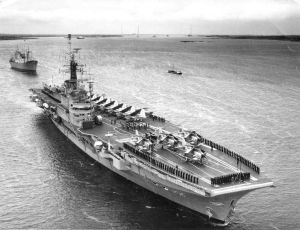
HMS Centaur was the first of the four Centaur-class light fleet carriers of the Royal Navy. She was the only ship of her class to be completed with the original design configuration of a straight axial flight deck, rather than the newly invented angled flight decks of her three later sister ships. She was laid down in 1944 in Belfast, with the contract being awarded to Harland and Wolff, but not launched until 22 April 1947 due to delays relating to the end of the war. She was commissioned on 1 September 1953, a gap of almost nine years from when she was laid down in 1944.

The Supermarine Scimitar was a single-seat naval strike aircraft designed and produced by the British aircraft manufacturer Supermarine. Operated exclusively by the Royal Navy's Fleet Air Arm, it was the final aircraft to be entirely designed and manufactured by Supermarine.

HMS Formidable was an Illustrious-class aircraft carrier ordered for the Royal Navy before the Second World War. After being completed in late 1940, she was briefly assigned to the Home Fleet before being transferred to the Mediterranean Fleet as a replacement for her crippled sister ship Illustrious. Formidable's aircraft played a key role in the Battle of Cape Matapan in early 1941, and they subsequently provided cover for Allied ships and attacked Axis forces until their carrier was badly damaged by German dive bombers in May.

HMS Argus was a British aircraft carrier that served in the Royal Navy from 1918 to 1944. She was converted from an ocean liner that was under construction when the First World War began and became the first example of the standard pattern of aircraft carrier, with a full-length flight deck that allowed wheeled aircraft to take off and land. After commissioning, the ship was involved for several years in the development of the optimum design for other aircraft carriers. Argus also evaluated various types of arresting gear, general procedures needed to operate a number of aircraft in concert and fleet tactics. The ship was too top-heavy as originally built and had to be modified to improve her stability in the mid-1920s. She spent one brief deployment on the China Station in the late 1920s before being placed in reserve for budgetary reasons.

849 Naval Air Squadron was a squadron of the Fleet Air Arm, the Air Arm of the British Royal Navy. It was formed during the Second World War as a carrier based torpedo-bomber, unit, flying missions against Japanese targets in the Far East. Its service since the Second World War has been as an airborne early warning squadron, flying fixed winged Skyraiders and Gannets from the Royal Navy's fixed wing carriers from 1952 until 1978, and airborne early warning Sea King helicopters from 1982 to 2018.

800 Naval Air Squadron was a Royal Navy Fleet Air Arm carrier-based squadron formed on 3 April 1933 by amalgamating No's 402 and 404 Flights.

700 Naval Air Squadron is an experimental test squadron in the Royal Navy’s Fleet Air Arm.
846 Naval Air Squadron is a squadron of the Royal Navy's Fleet Air Arm.

815 Naval Air Squadron is a squadron of the Fleet Air Arm, part of the Royal Navy, based at RNAS Yeovilton in Somerset; it is the Navy's front line Wildcat Naval Air Squadron. It comprises AgustaWestland Wildcat HMA.2 helicopters and is the largest helicopter squadron in western Europe.
801 Naval Air Squadron (NAS) was a Fleet Air Arm squadron of the Royal Navy formed in 1933 which fought in World War II, the Korean War and the Falklands War.
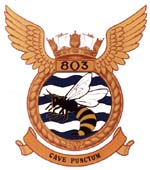
803 Naval Air Squadron was a Royal Navy Fleet Air Arm squadron.
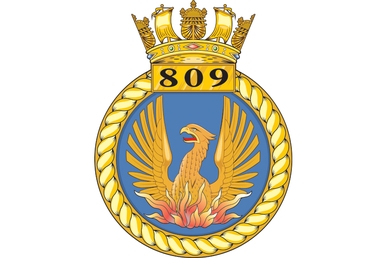
809 Naval Air Squadron is a squadron of the Fleet Air Arm of the United Kingdom. It was formed in 1941 and flew in the Soviet Union, the Mediterranean and the Far East during World War II. After active service during the Suez Crisis, 809 was disbanded in 1959. Reformed in 1963 to fly Buccaneers, the squadron was disbanded briefly in 1965-66, and then again in 1978. A brief period during the Falklands war saw 809 reformed to bring Sea Harrier aircraft south to the UK task group and to fly from Illustrious.
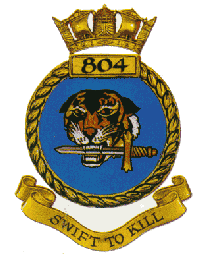
804 Naval Air Squadron was a Naval Air Squadron of the Royal Navy, formed in November 1939 from part of 769 NAS Sea Gladiators which had been detached to RNAS Hatston. The squadron was merged into 800 NAS in June 1944 and subsequently reformed in September.

820 Naval Air Squadron is a Royal Navy Fleet Air Arm carrier-based squadron flying the AgustaWestland Merlin HM2 in an Anti-Submarine role from RNAS Culdrose.
810 Naval Air Squadron was a Royal Navy Fleet Air Arm carrier based squadron formed on 3 April 1933 with the amalgamation of the 12 Blackburn Dart aircraft from 463 and 44 Flight Flights Royal Air Force to the Fleet Air Arm. The squadron saw action during the Second World War, the Suez Crisis and the Korean War.

808 Naval Air Squadron was a Royal Navy Fleet Air Arm carrier based squadron formed in July 1940. It served on a number of the Navy's aircraft carriers during the Second World War, serving in most of the theatres of the war, before decommissioning at the end of the war. It was re-formed in 1950 as 808 Squadron RAN, a carrier-based attack squadron of the Royal Australian Navy's Fleet Air Arm, and saw action during the Korean War before disbanding again in 1958.
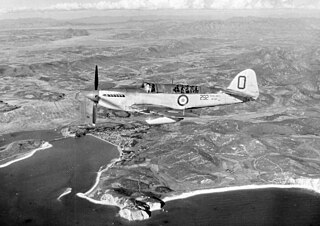
825 Naval Air Squadron is a Royal Navy Fleet Air Arm Naval Air Squadron which was re-commissioned on 10 October 2014 and currently flies the AgustaWestland Wildcat HMA.2.
802 Naval Air Squadron was a Naval Air Squadron of the Royal Navy's Fleet Air Arm.

Ronald Cuthbert Hay, was a British naval aviator and the only Royal Marine fighter ace. He joined the Royal Marines in 1935 and then served as an aviator with the Fleet Air Arm. In 1940 he joined 801 Naval Air Squadron flying the two seater Blackburn Skua on HMS Ark Royal for the Norwegian Campaign, claiming his first victory on his first operational flight. He took part in operations covering the evacuation of the British Expeditionary Force from the Dunkirk beaches. Then flying the Fairey Fulmar joined 808 Naval Air Squadron during the Battle of Britain.
1831 Naval Air Squadron was a Naval Air Squadron of the Royal Navy's Fleet Air Arm. The squadron was formed in 1943 in Rhode Island, before being disbanded after its return to Britain in 1946. It was reformed a year later, as part of the Royal Navy Volunteer Reserve where in 1955 it became the first jet-equipped squadron of the Royal Navy Voulenteer Reserve, before being disbanded in 1957. It was later briefly reformed between 1980-81 to assist in training aircrew.















